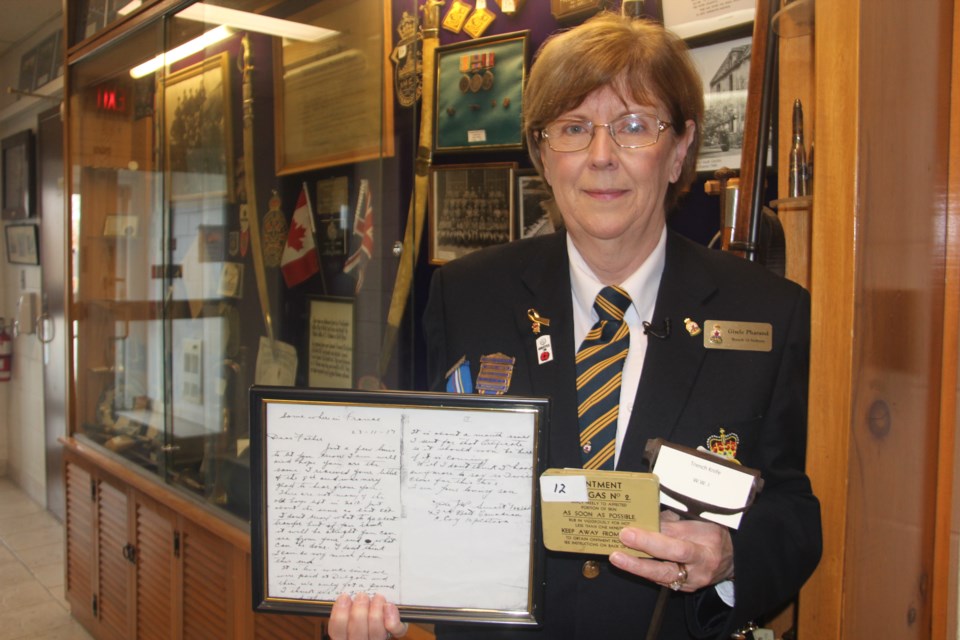“To you from falling hands we throw/The torch; be yours to hold it high.”
These words from the poem “In Flanders Fields” by Canadian physician Lieutenant-Colonel John McCrae resonate for Ron Robitaille as the 100th anniversary of the First World War armistice approaches this Nov. 11.
The famous poem, often recited at Remembrance Day ceremonies, was written on May 3, 1915 by McCrae of Guelph, Ont. after one of his friends was killed in battle. In all, 67,000 Canadians were killed in the bloody 1914-1918 conflict.
McCrae himself did not live to see the war's end — he died at age 45 on Jan. 28, 1918 after contracting pneumonia and cerebral meningitis.
Robitaille, past-president of Branch 76 of the Royal Canadian Legion, points out that all Canadian First World War veterans have now passed on.
That fact makes it all the more important to pass the torch of remembrance to new generations, he said.
“That last paragraph (of “In Flanders Fields”) is telling us what we should do,” Robitaille said.
“We should hold a torch of remembrance high and do the stuff that we need to do never to forget the sacrifice that these soldiers made for us.
“I think we should remember because they gave their lives and also they provided us with the freedom that we enjoy today.”
Bells of Peace
He invites all those interested in marking the First World War armistice centenary to take part in the Remembrance Day ceremony at the Sudbury Arena this Sunday. People are asked to arrive around 10 a.m.
A bell will be rung 100 times during the ceremony. This is part of a larger project called Bells of Peace by the Royal Canadian Legion to mark the First World War armistice centenary.
On Nov. 11, at the going down of the sun, communities across Canada will mark the 100th anniversary of the end of the First World War with the ringing of 100 bells. The ringing of bells emulates the moment in 1918 when church bells across Europe tolled as four years of war had come to an end.
Beyond the bells tolling during the Sudbury Arena ceremony, several local churches have confirmed their participation in the initiative.
Housing History
Branch 76 of the Royal Canadian Legion, the oldest branch in Greater Sudbury, was actually formed by First World War veterans 92 years ago, in 1926.
It houses a collection of First World War photos and memorabilia. Check out our video below of Branch 76 poppy campaign manager Gisele Pharand showing us some of these items and sharing her thoughts on the anniversary.
Project Honour and Preserve
For the past eight years, Huntington University president Kevin McCormick, who's also the Honorary Colonel of the Irish Regiment of Canada, has taken part in a personal project called Project Honour and Preserve.
He purchases military memorabilia such as medals and letters, and reunites them with family members or museums. “It's a small way to say thank you,” McCormick said.
Some of that memorabilia is from the First World War. McCormick said he's most amazed at the trench art, where soldiers used items like shell casings to make something beautiful in a few rare moments of peace.
McCormick said the First World War armistice centenary is “an incredibly important date for our country and the world,” recognizing the millions of lives that were lost during that conflict.
At the same time, McCormick said he thinks we should also use the occasion to reflect on Canadian men and women who have served in more recent conflicts, and come home with wounds both visible and invisible.
Hundred Days Offensive
Looking at the First World War armistice on Nov. 11, 1918 from a historical perspective, Dieter Buse said it came at the end of a bloody period called the Hundred Days Offensive.
Throughout these three final months, Canadian troops saw action in several areas, substantially driving back the Germans. In this period, the Canadian Corps suffered 46,000 casualties.
The casualty list from the last few days of the war includes at least 10 soldiers from Sudbury, said Buse, a Laurentian University professor emeritus, who, with former colleague Graeme Mount, recently published the book “Untold: Northeastern Ontario's Military Past Volume 1, 1662- World War 1.”
He and Mount were able to track down 305 First World War soldiers born in the Sudbury district, while 915 lived there at least some time before the conflict. About 10 per cent of these soldiers died.
The armistice of Nov. 11, 1918 was signed on a railway car in Compiègne, France, ending the fighting on land, sea and air in the First World War between the Allies and the Germans.
It came into force at 11 a.m. Paris time, hence the saying “the eleventh hour of the eleventh day of the eleventh month.”
People were just glad the war which killed an estimated nine million combatants and seven million civilians worldwide had finally ended, and the armistice meant peace, which they celebrated, Buse said.
Modern Technology
Although it's a 100-year-old conflict, Buse said interest in the First World War is currently high.
That's partly because it's now possible to do an online search through Library and Archives Canada of the service records for the 620,000 Canadian soldiers who enlisted in the First World War. You can check that out here.
By the way, don't be alarmed if you find out your ancestor had venereal disease — about a fifth of the Canadian forces did, Buse said.
The historian invites anyone who might have questions about tracking down their relatives' First World War records to contact him at [email protected].
“The period itself, we have enough distance to it that we can have a larger perceptive,” Buse said.
“Within that perspective, we know now where to place relatives, friends, and we have the methods of getting at that information.”
